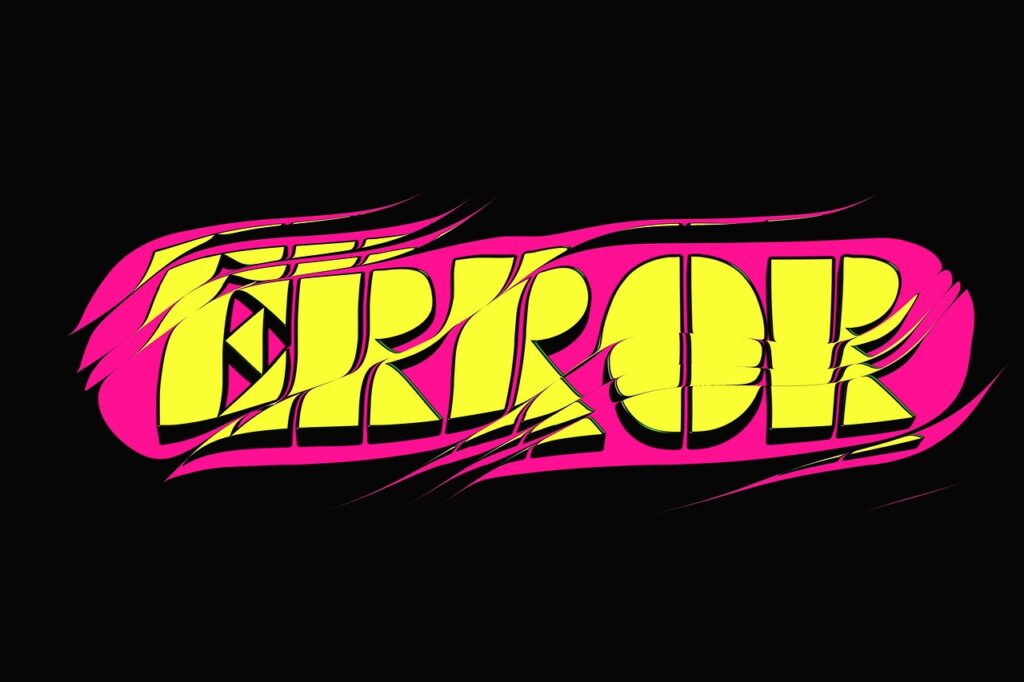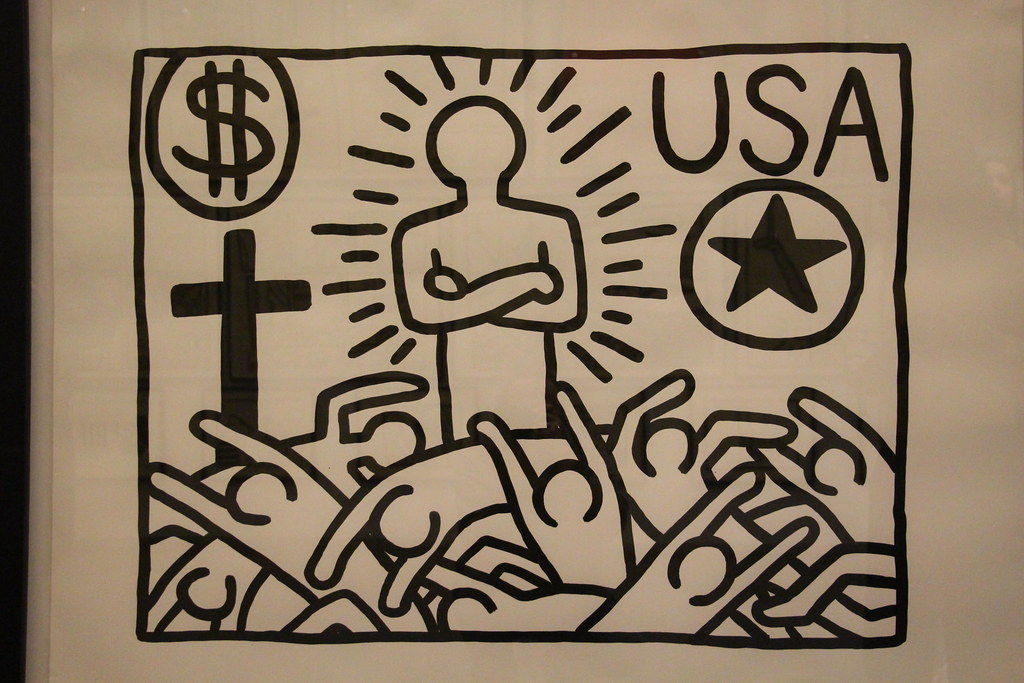
The art world, a vibrant and often tumultuous arena, has consistently served as a crucible for societal values, pushing the boundaries of aesthetics, morality, and public perception. Throughout history, certain exhibitions and artworks have transcended mere display to become flashpoints of controversy, eliciting intense public outcry, sparking fierce debates, and fundamentally reshaping our understanding of what art can be, its purpose, and its limits. These moments of contention are not merely footnotes in art history; they are integral to the ongoing dialogue between creation and interpretation, reflecting deeper societal tensions and transformations.
From challenging religious dogma to confronting political sensitivities and subverting traditional notions of beauty, provocative art serves as a mirror, reflecting humanity’s anxieties, aspirations, and discomforts. This in-depth exploration delves into some of the most contentious art exhibits and individual works that have caused significant uproar, examining the catalysts for their controversy, the diverse reactions they provoked, and their lasting impact on both the art world and the broader cultural landscape. These narratives highlight the inherent power of art to question conventions and provoke thought, often by pushing the boundaries of what is considered acceptable or even comprehensible.
Understanding these controversies helps us appreciate the challenges and risks involved in creating new and bold designs in the automotive industry; however, in the realm of art, it deepens our appreciation for the courage of artists and institutions alike to engage with difficult subjects. It also sheds light on the evolving dynamics between artists, audiences, critics, and governing bodies, revealing how each plays a role in defining the ever-shifting parameters of artistic freedom and public discourse. This article will examine a selection of these polarizing moments, each a testament to art’s enduring capacity to stir, challenge, and ultimately, transform.

1. “The Physical Impossibility of Death in the Mind of Someone Living” by Damien Hirst (1991)
In 1991, the art world was undeniably rocked by Damien Hirst’s renowned piece, which starkly featured a preserved tiger shark hung in formaldehyde. This contentious work, boldly titled “The Physical Impossibility of Death in the Mind of Someone Living,” immediately thrust into the forefront profound issues concerning the very definition of art itself, alongside the complex moral treatment of animals within an artistic context. Its confronting nature ensured it would be a subject of intense scrutiny and widely varied interpretations.
Upon its initial unveiling, the public and critical response was sharply divided. While some critics vehemently contended that Hirst’s reliance on a pronounced “shock factor” overshadowed any genuine artistic worth, dismissing it as mere sensationalism, others offered a contrasting perspective. These proponents lauded the work for its daring conceptual framework and its undeniable capacity to elicit in-depth philosophical thought, particularly around mortality and the fragility of life.
The artwork served as a potent catalyst for discussions that extended far beyond the gallery walls. It forced observers to grapple with existential questions about life, death, and the boundaries of art, challenging conventional notions of beauty and aesthetic pleasure. The piece’s raw confrontation with a primal fear resonated deeply, cementing its place as a seminal work in the contemporary art canon, one that continues to provoke reflection on the ephemeral nature of existence and the role of the artist in society.
Furthermore, the use of a real animal, preserved in such a dramatic fashion, brought ethical considerations to the forefront, prompting debates about the responsibility of artists to their subjects and the broader ecological implications of their work. Hirst’s piece pushed the envelope, not just aesthetically but also ethically, ensuring its controversial status and its enduring relevance in discussions about modern art’s purpose and impact.
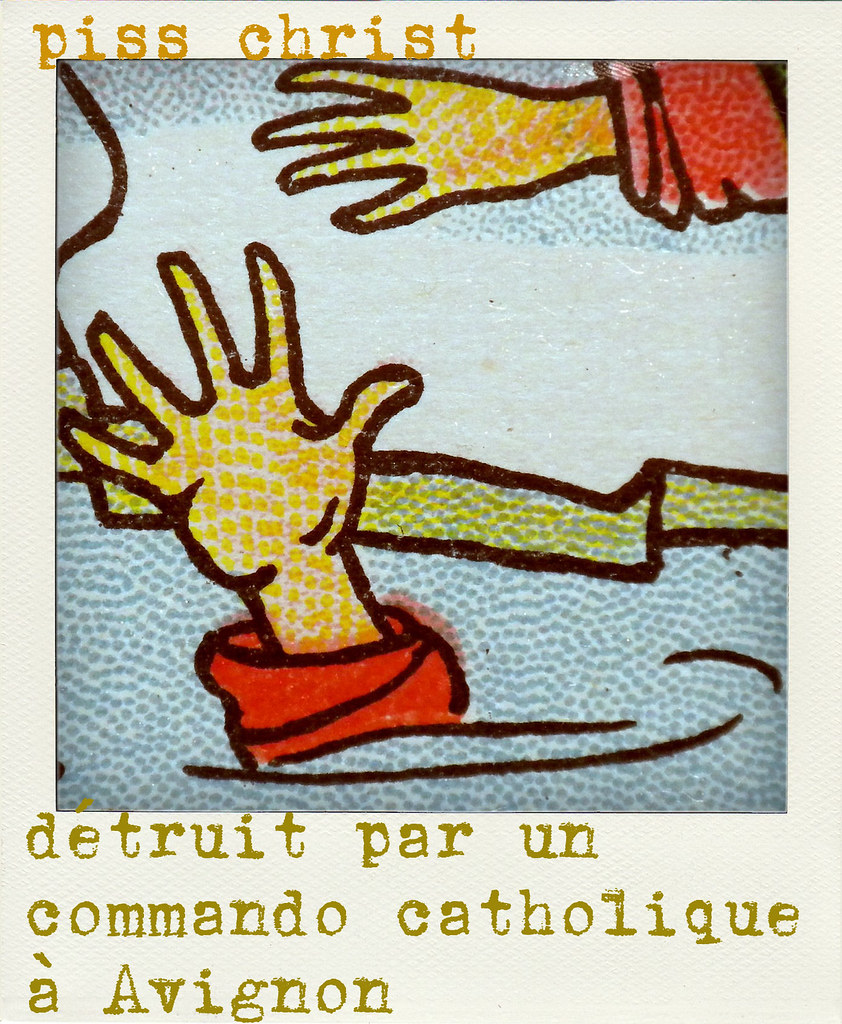
2. “Piss Christ” by Andres Serrano (1987)
Andres Serrano’s “Piss Christ,” created in 1987, ignited an immediate and intense blaze of debate that transcended artistic circles to permeate religious and political spheres. The photographic image, which depicted a small plastic crucifix immersed in a container of the artist’s own urine, was perceived by many as a deliberate act of desecration, sparking outrage and condemnation across various segments of society.
The artwork’s visceral imagery caused immense uproar among religious organizations, lawmakers, and conservative critics, primarily because it directly challenged societal taboos pertaining to sacred religious symbols and reverence. For many, it represented a blatant affront to their faith, an act of sacrilege that crossed an unforgivable line, leading to calls for its removal and even public funding cuts for the arts.
Conversely, a significant portion of critics and advocates for artistic freedom praised Serrano’s piece as a powerful and legitimate expression of artistic liberty. They argued that the work was not merely an act of provocation but a profound statement on the commercialization of religious symbols and the often-superficial treatment of faith in contemporary culture. This perspective viewed the artwork as a critique rather than an attack, aiming to provoke introspection rather than mere offense.
This profound divergence in interpretation underscored the complex relationship between art, religion, and public funding, illustrating how a single image could be simultaneously perceived as blasphemous and profoundly critical. The controversy surrounding “Piss Christ” became a landmark case in debates about freedom of expression, censorship, and the role of government in regulating artistic content, leaving an indelible mark on the discourse surrounding provocative art.
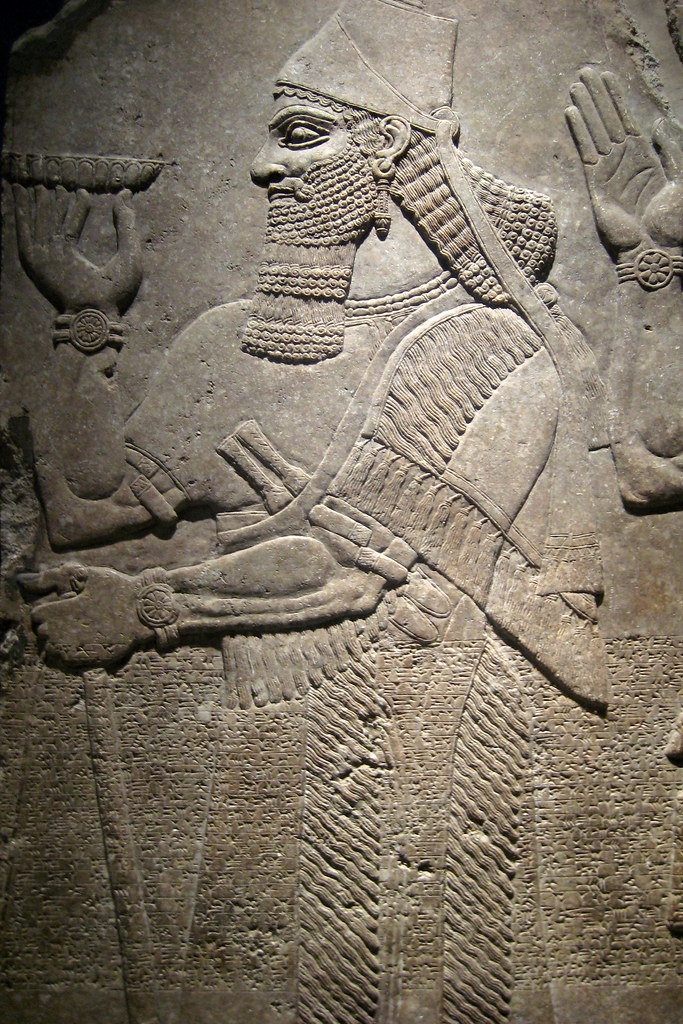
3. “Sensation” at the Brooklyn Museum (1999) featuring “The Holy Virgin Mary” by Chris Ofili
In 1999, the “Sensation” exhibition at the Brooklyn Museum became a profound flashpoint for debate, drawing an extraordinary level of public and political scrutiny. The exhibition, curated by Charles Saatchi, featured works by the Young British Artists (YBAs), a group known for their boundary-pushing and often confrontational creations. While several pieces generated discussion, it was Chris Ofili’s “The Holy Virgin Mary” that ignited the most intense and widespread outrage.
Ofili’s painting depicted a black Madonna, rendered with glitter, resin, and magazine cutouts of female genitalia, but the most controversial element was its use of elephant dung, prominently incorporated onto the canvas. This unconventional material, perceived by many as offensive and sacrilegious, was the primary catalyst for the widespread outcry and vehement calls for the artwork’s suppression, escalating the controversy beyond artistic critique into a heated cultural battle.
The public and political backlash was swift and severe. Then-New York City Mayor Rudy Giuliani publicly denounced the artwork, threatening to cut city funding to the museum if the exhibition continued to display it, labeling it “sick” and “disgusting.” This governmental intervention sparked new discussions about religious intolerance, the rights of free speech within artistic expression, and the appropriateness of public support for art deemed contentious or offensive by segments of the populace.
Critics of the artwork often cited their religious sensibilities as being deeply offended, viewing the use of dung and pornographic imagery in connection with a sacred figure as a direct attack on their faith. Conversely, defenders of the artwork and the museum argued forcefully for artistic freedom and the importance of allowing diverse perspectives in cultural institutions. They maintained that the piece was not intended to blaspheme but to explore complex themes of identity, race, and spirituality through a post-colonial lens, challenging traditional Western depictions of the Virgin Mary.
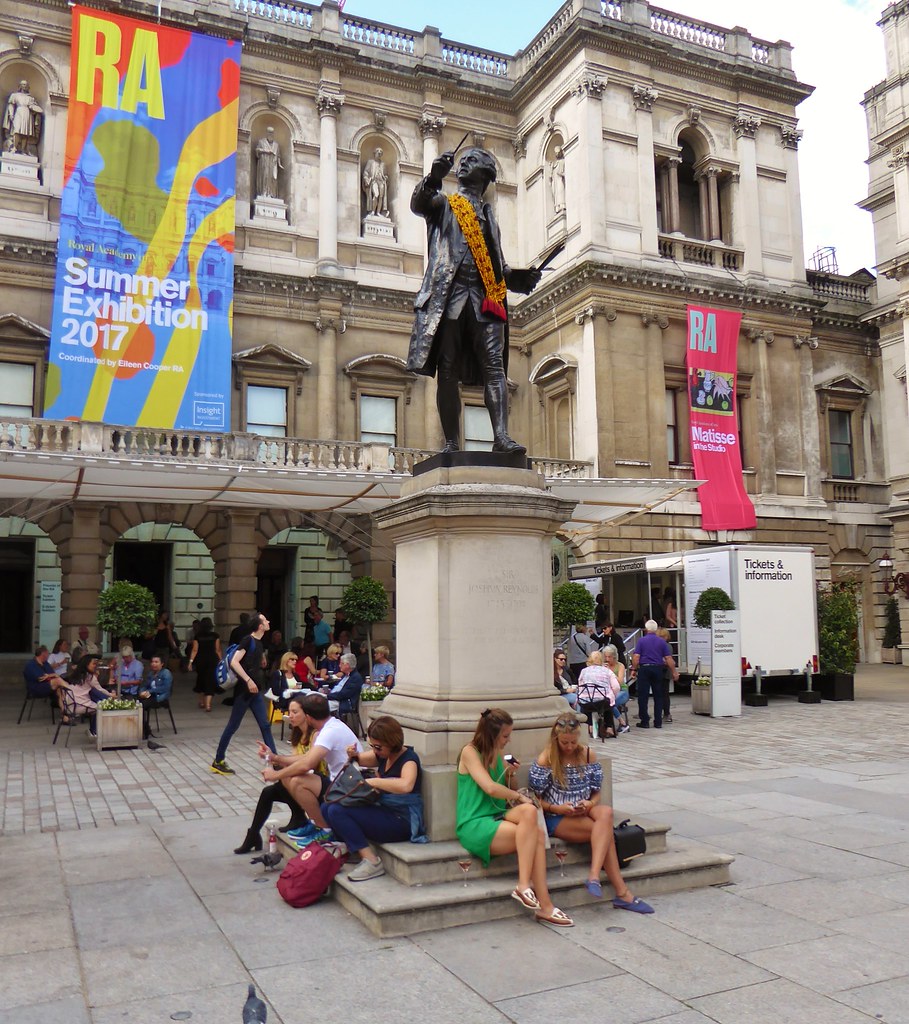
4. “Myra” by Marcus Harvey (1997)
When it was displayed at the Royal Academy in 1997 as part of the “Sensation” exhibition, Marcus Harvey’s striking portrait of renowned child killer Myra Hindley sparked an immediate and profound public outcry. The enormous painting, meticulously created from the handprints of many children, was seen as a deeply provocative piece, pushing the boundaries of what was considered acceptable subject matter within the realm of art and igniting a heated controversy among the public and the media alike.
The artwork’s choice of subject — a notorious figure associated with horrific crimes against children — elicited strong moral condemnation. Many viewers and commentators found the depiction of Hindley, even in an abstract or symbolic manner, to be insensitive, exploitative, and potentially glorifying a criminal whose actions had caused immeasurable pain. The use of children’s handprints further intensified the emotional charge, making the work even more disturbing for a public still deeply affected by the crimes.
While some justified the artwork as a powerful statement on the dark side of human nature and the inherent significance of art in confronting difficult and uncomfortable realities, these arguments often struggled to gain widespread acceptance amidst the public’s visceral reaction. Proponents argued that the work forced a necessary, albeit painful, confrontation with evil and memory, exploring the societal fascination with infamy. They suggested that art’s role sometimes involves unsettling the audience to provoke deeper thought.
However, the dominant sentiment was one of profound discomfort and anger, with many contending that the artwork crossed an ethical line by dredging up trauma and appearing to legitimize or even valorize a figure of pure villainy. “Myra” highlighted the complex ethical considerations artists face when depicting controversial historical figures, demonstrating how artistic intent can often be overshadowed by public perception and deeply held moral objections, particularly when the subject touches on collective trauma.
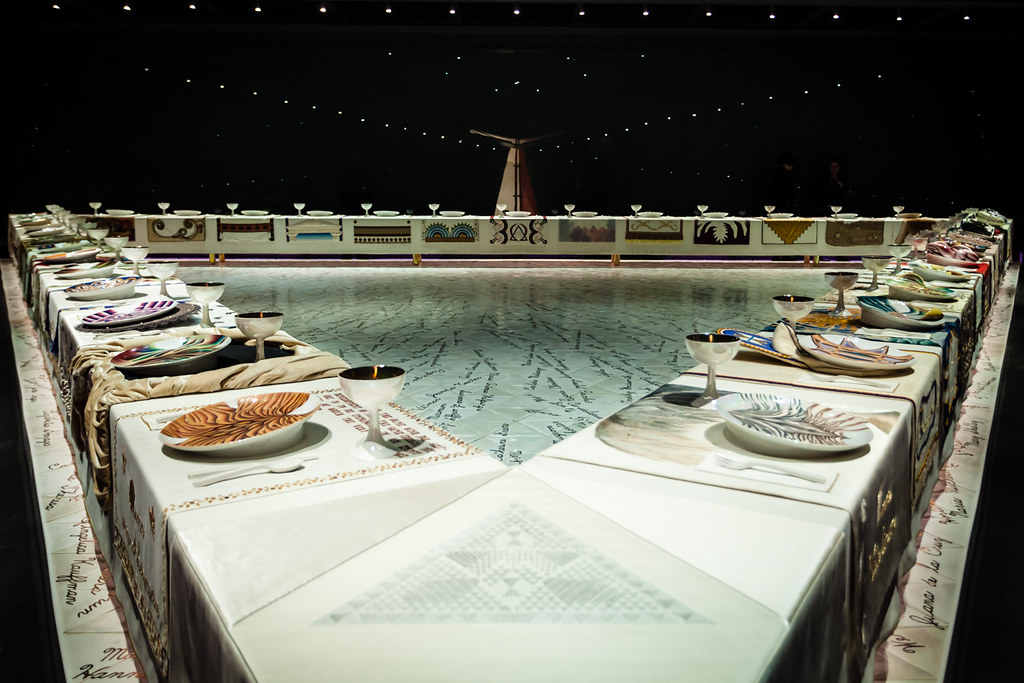
5. “The Dinner Party” by Judy Chicago (1979)
“The Dinner Party,” a groundbreaking installation conceived by Judy Chicago and first exhibited in 1979, swiftly provoked a torrent of both debate and enthusiastic positive reviews. This monumental piece of art, structured as a triangular table, featured 39 elaborate place settings, each meticulously designed to represent a significant woman in Western history, with an additional 999 names inscribed on the ceramic tile floor beneath. It was a powerful and ambitious statement intended to reclaim women’s rightful place in historical narratives.
However, it was the explicit imagery on the porcelain plates that became the focal point of much of the controversy. Each plate, uniquely crafted for its representative woman, featured boldly rendered, often abstract, images of female genitalia. This candid and unapologetic depiction directly defied conventional norms regarding female uality and public modesty, challenging the prudishness that had historically veiled discussions of women’s bodies and experiences.
The artwork’s frankness horrified some viewers, who denounced it as obscene, vulgar, and unsuitable for public display, particularly within a museum setting. Critics from traditional art circles often dismissed it as didactic, lacking aesthetic refinement, or simply too literal in its feminist message. They found the overt symbolism jarring and argued that it reduced complex historical figures to a singular biological characteristic, thereby limiting their broader contributions.
Conversely, a vast number of feminists, art historians, and cultural critics lauded “The Dinner Party” as an undeniable feminist masterpiece. They celebrated its audacious challenge to patriarchal art history, its intricate craftsmanship, and its role in bringing marginalized women’s histories into the mainstream. For supporters, the explicit imagery was not gratuitous but essential—a powerful visual reclamation of female anatomy and a celebration of female power and identity, making it a pivotal work in the burgeoning feminist art movement and a symbol of artistic liberation.
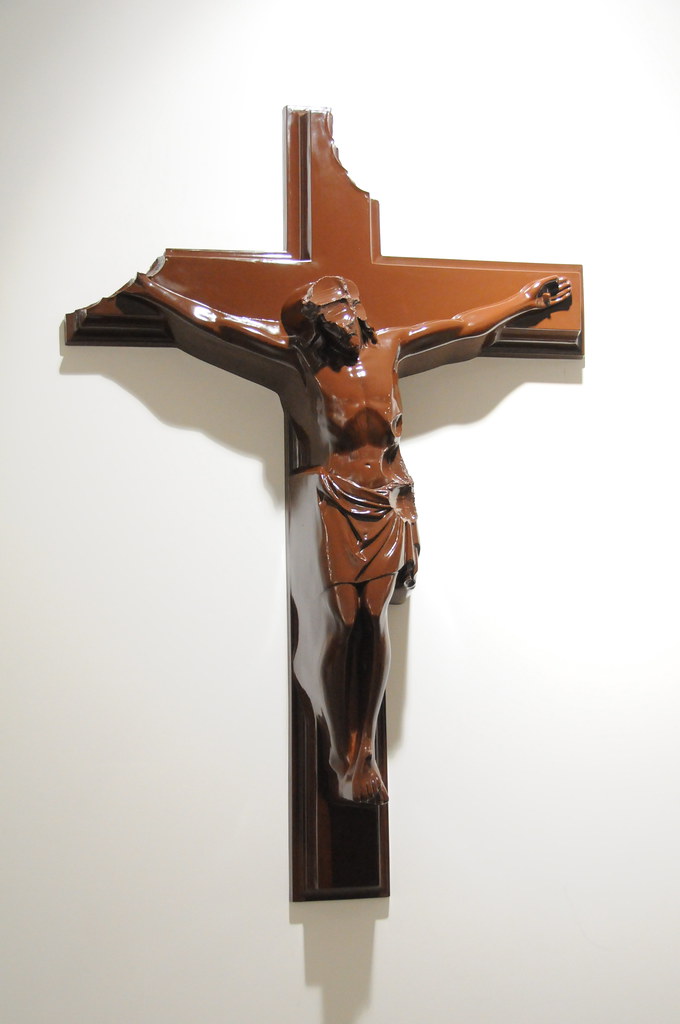
6. “Chocolate Jesus” by Cosimo Cavallaro (2007)
Cosimo Cavallaro’s “Chocolate Jesus” sculpture, unveiled in 2007, quickly sparked a heated religious discussion and considerable public outcry. The life-size sculpture, crafted entirely from chocolate, depicted a Jesus Christ, a visual choice that immediately struck many as deeply sacrilegious and offensive. The use of an everyday, consumable material like chocolate for such a revered religious figure was perceived by critics as trivializing and disrespectful, intensifying the controversy.
According to the artist, the artwork was intended to explore a complex array of issues, including temptation, consumerism, and the pervasive commercialization of holy icons within modern society. Cavallaro aimed to provoke thought about how sacred symbols are often commodified and consumed, both literally and figuratively, in a world driven by material desires. His intent was to spark dialogue, rather than merely offend, by presenting a familiar figure in an unexpectedly challenging medium.
However, the piece was widely deemed rude and blasphemous by conservative critics and religious organizations, who saw it as an unacceptable affront to Christian beliefs. For these groups, the artist’s stated intentions were overshadowed by the perceived insult to a central figure of their faith. The ness of the figure, combined with the choice of chocolate, was interpreted as a deliberate act of mockery, regardless of any deeper conceptual underpinnings.
The intensity of the backlash led to the sculpture being removed from a planned exhibition in a New York City gallery, demonstrating the profound conflict that can arise when artistic statements clash with deeply held religious sensitivities. “Chocolate Jesus” highlighted the delicate balance artists must navigate between conceptual critique and potential offense, underscoring how interpretations of sacred imagery can become highly contentious grounds for public debate and artistic censorship.
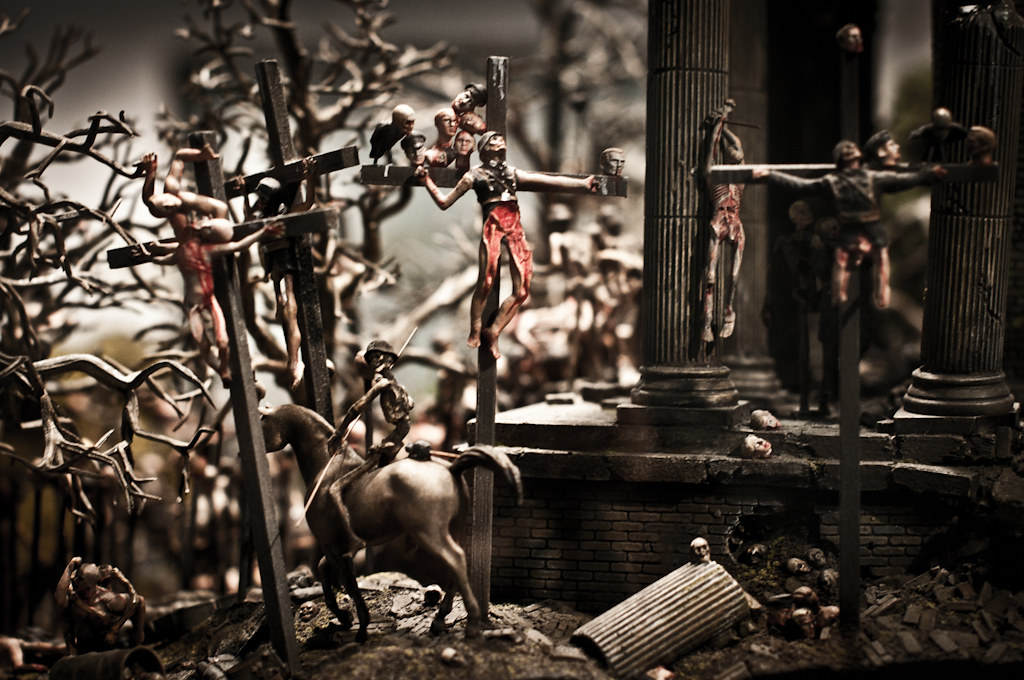
7. The Chapman Brothers: “Hell” (2000)
Jake and Dinos Chapman’s “Hell” exhibition, first displayed in 2000, horrified viewers and critics alike with its macabre and deliberately horrific visuals. This monumental installation consisted of nine intricate dioramas, each depicting grotesque scenes of violence, torture, and degradation on an apocalyptic scale. The artists populated these nightmarish landscapes with thousands of miniature figurines, primarily mannequins of young children, engaged in acts with Nazi soldiers, often performing violent and ual behaviors, creating a deeply unsettling and disturbing tableau.
The artwork’s explicit and profoundly disturbing content immediately brought up critical issues concerning censorship, the very boundaries of creative representation, and the function of shock value in modern art. The brothers, known for their provocative and confrontational approach, deliberately pushed the limits of taste and acceptability, aiming to provoke a visceral reaction that would force viewers to confront uncomfortable truths about human depravity and historical atrocities.
While some critics denounced the artwork as being overtly rude, gratuitously offensive, and in extremely poor taste, arguing that its shock tactics overshadowed any meaningful artistic message, others vigorously defended it. Proponents argued on the grounds of its aesthetic quality, despite its subject matter, and, more importantly, the powerful, albeit subversive, messages it contained regarding the horrors of war, the nature of evil, and the loss of innocence. They contended that the work was a profound, albeit brutal, commentary on humanity’s darkest impulses and historical traumas.
The exhibition exemplified how certain art pieces, by delving into the most extreme aspects of human experience, can divide opinion sharply, prompting intense debates about the artist’s right to explore any subject matter, no matter how uncomfortable. “Hell” stands as a potent example of how art can function as a disturbing mirror, reflecting societal fears and historical wounds, even if the reflection is too unsettling for many to bear, and solidifying the Chapman Brothers’ reputation for uncompromising and controversial artistic statements.
Continuing our exploration into the contentious landscape of the art world, the modern era presents a new tapestry of controversies, reflecting shifts in societal values, technological advancements, and evolving perceptions of authenticity and purpose. These more recent and conceptual flashpoints reveal how art grapples with political commentary, institutional critique, the advent of artificial intelligence, and the very essence of value and meaning in a rapidly changing global context.

8. Activist Vandalism of Cultural Heritage (2024)
In 2024, the strategy of targeting cultural heritage in the name of protest saw a continued, and often intensified, application by groups such as Just Stop Oil and other climate activist organizations. Esteemed works and historical landmarks, including the Magna Carta, the “Mona Lisa,” and Stonehenge, became subjects of these disruptive demonstrations, designed to draw global attention to environmental concerns. Such acts inevitably ignited fervent debates about the appropriate boundaries of protest, the sanctity of artistic and historical artifacts, and the broader societal value placed on cultural preservation.
The repercussions for those involved varied significantly, underscoring the legal complexities surrounding such actions. For instance, in the Netherlands, three Belgian activists who targeted Johannes Vermeer’s “Girl with a Pearl Earring” saw their two-month prison sentences overturned on appeal, having spent 23 days in detention. This contrasted sharply with the outcome in September, when a British judge handed down lengthy custodial sentences—two years and 20 months respectively—to two young demonstrators who had attacked Vincent van Gogh’s “Sunflowers” with tomato soup. These disparate rulings highlight the inconsistent judicial responses to art-related activism across different jurisdictions.
In response to these escalating threats, cultural institutions have been compelled to re-evaluate and enhance their security protocols. London’s National Gallery, a recurrent target in recent years, notably augmented its measures by implementing stricter controls on liquids and large bags brought into its premises. Such institutional adaptations reflect a growing concern within the art community about safeguarding invaluable collections while navigating the challenging intersection of artistic expression, protest, and public access.

9. **Maurizio Cattelan’s “Comedian” and the Evolution of Value (2024)
Maurizio Cattelan’s “Comedian,” an artwork consisting of a banana duct-taped to a wall, first captured international headlines in 2019 when an edition controversially sold for $120,000. This seemingly simplistic yet profoundly provocative piece immediately sparked a global discourse on the definition of art, the nature of artistic value, and the often-baffling economics of the contemporary art market. Its initial sale ignited outrage and amusement in equal measure, cementing its status as a cultural phenomenon.
The artwork re-entered the spotlight in November of this year, challenging perceptions even further when an edition was offered at auction with an estimated value of $1 million to $1.5 million. This audacious valuation signaled a significant escalation in the perceived worth of a piece that many still struggled to reconcile with traditional artistic criteria. The subsequent bidding battle underscored the speculative and often irrational dynamics that can influence the market for conceptual art.
Ultimately, Chinese billionaire Justin Sun acquired the viral work for a staggering $6.2 million. For this substantial sum, the cryptocurrency entrepreneur received not the original fruit, but a fresh banana, a roll of duct tape, a certificate of authenticity, and detailed installation instructions. Sun’s subsequent public act of eating the banana during a press conference in Hong Kong, stating his desire to “become part of the (artwork’s) history,” further blurred the lines between artwork, performance, and the very concept of ownership and engagement with a piece designed to provoke endless reinterpretation.

10. The Advent of AI in Creative Industries (2024)
The year 2024 marked a pivotal moment in the ongoing debate surrounding artificial intelligence’s integration into creative fields, following Japanese author Rie Kudan’s admission regarding her Akutagawa Prize-winning novel, “The Tokyo Tower of Sympathy.” Shortly after receiving the prestigious literary award, Kudan revealed that approximately 5% of her acclaimed work had been generated, word-for-word, by ChatGPT. This disclosure immediately ignited renewed “existential questions about the threat AI poses to the creative industries,” prompting a broader reflection on authorship, originality, and the future of human artistic endeavor.
Kudan’s public stance on the matter was notably unapologetic, as she asserted her intention to “continue to profit from the use of AI in the writing of my novels, while letting my creativity express itself to the fullest.” Her statement underscored a burgeoning philosophy among some creators who view AI as a tool for enhancement rather than a replacement for human ingenuity. This perspective suggests a future where the collaboration between human artists and artificial intelligence may become an increasingly accepted, albeit contested, aspect of artistic production.
A poignant counterpoint to this narrative emerged in June, when photographer Miles Astray intentionally submitted a genuine photograph of a flamingo into the AI category of the 1839 Awards’ Color Photography Contest, ultimately winning the People’s Vote award. Astray’s deliberate act was a direct challenge to the burgeoning AI dominance, aiming to “prove that human-made content has not lost its relevance” and that “Mother Nature and her human interpreters can still beat the machine.” This incident provided a powerful human-centric narrative amidst the anxieties surrounding AI’s growing capabilities, reinforcing the unique value of human perception and creation.
Read more about: 9 Compact Cars Making a Big Splash in 2025: Expert Picks and Detailed Analysis

11. MONA’s “Ladies Lounge”: Discrimination and Authenticity (2024)
The women-only “Ladies Lounge” at the Museum of Old and New Art (MONA) in Tasmania, Australia, designed to explore themes of misogyny, became the nexus of two distinct controversies this year. The first erupted when a disgruntled male visitor, denied entry, filed a complaint that led a local tribunal to order the space to cease refusing access to “persons who do not identify as ladies.” This ruling immediately sparked intense discussions about gender-exclusive spaces in cultural institutions and the complexities of discrimination laws in artistic contexts.
In response to the tribunal’s order, artist and curator Kirsha Kaechele chose to close the “Ladies Lounge” rather than admit men. As part of this decision, three artworks purported to be by Picasso, which had been part of the original installation, were relocated to a women’s restroom. The plot thickened significantly when Kaechele subsequently admitted to forging these “Picassos” herself, explaining that her intention was for them to match the original space’s color scheme and green silk curtains. This revelation added a layer of profound commentary on authenticity, artistic license, and the subversive potential of institutional critique.
By December, the Supreme Court of Tasmania had overturned the discrimination ruling, allowing the “Ladies Lounge” to reopen. However, a new, nuanced approach was implemented, where a limited number of tickets were made available to men through a ballot process on specific days for “domestic arts lessons and other reparations,” as stated by the museum. This evolving situation at MONA exemplifies the complex and often performative negotiations between artistic intent, public reception, and the legal and ethical boundaries of exhibition practices in contemporary institutions.
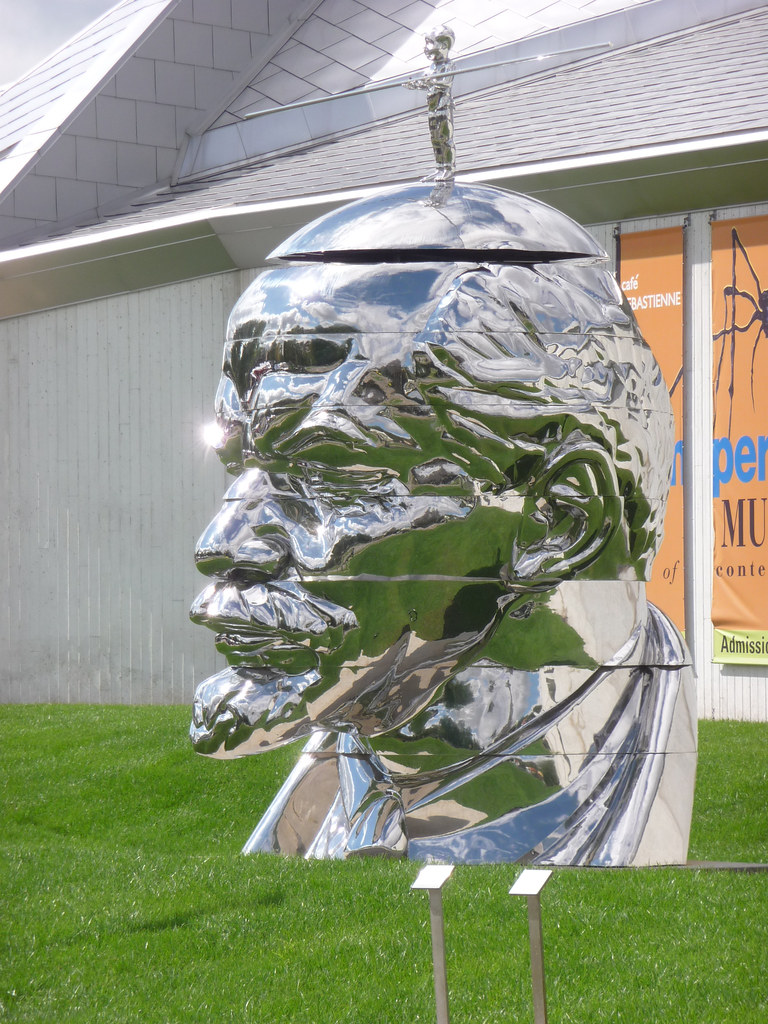
12. The Detention of Political Artist Gao Zhen in China (2024)
The Chinese artist duo, the Gao Brothers—Gao Zhen and Gao Qiang—have long been known for their provocative sculptures, particularly those depicting Mao Zedong, created during a relatively more liberal era for artistic expression over a decade ago. Their work consistently challenged the official narrative and legacy of China’s former ruler, often stirring controversy by engaging with sensitive political subjects. This historical context underscores the significant risks artists face when their creations intersect with state-controlled ideology.
In September of this year, Gao Zhen, at 68 years old, was detained by Chinese authorities. According to his brother and artistic partner, Gao Qiang, police raided Zhen’s art studio on the outskirts of Beijing. The official suspicion cited was “slandering China’s ‘heroes and martyrs,’” an offense that carries a potential penalty of up to three years in prison. This action by the authorities represents a stark crackdown on artistic freedom and a clear signal regarding the narrowing space for political commentary within the arts in China.
Despite inquiries from international media, including CNN, the public security bureau in Hebei province’s Sanhe city, accused by Gao Qiang of detaining his brother, declined to provide any comment at the time. Gao Zhen has remained in detention, with regular updates posted on the duo’s Facebook page highlighting his ongoing confinement. This case serves as a powerful and troubling illustration of how political commentary in art can lead to severe repercussions for artists in authoritarian contexts, reinforcing the critical role of artistic freedom as a cornerstone of open societies.
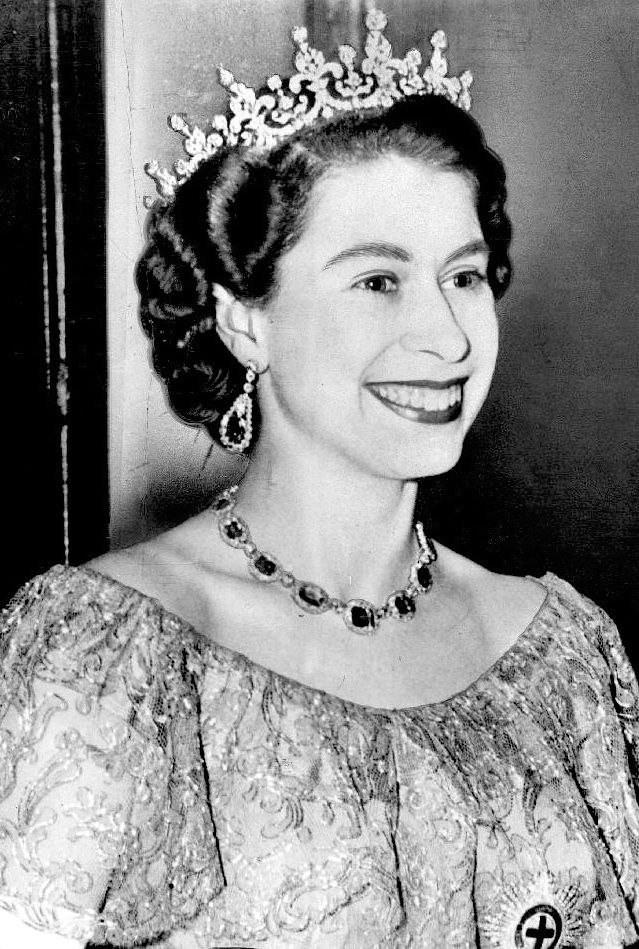
13. Divisive Royal Portraits and Public Perception (2024)
In 2024, the British royal family’s efforts to update their public image post-Queen Elizabeth II’s death were met with significant public and critical scrutiny, particularly concerning official portraits. King Charles III’s first official portrait since his coronation, painted by British artist Jonathan Yeo, became a major talking point. The aggressively red, 8.5- by 6.5-foot painting elicited a wide spectrum of reactions on social media, with some describing it as a “visual representation of the massacre cause by colonizers” and others finding it reminiscent of a descent “straight to hell.”
The diverse public response highlighted the complex and often highly personal interpretations of royal imagery in a contemporary context. While some commentators were sharply critical, others, like art historian Richard Morris, expressed appreciation, noting that before photography, a great painter would “capture your real appearance you accepted the revelation of your flaws and your mortality.” This divergence in opinion underscored how traditional portraiture, when depicting figures of national importance, inevitably becomes a canvas for broader societal sentiment and political commentary.
Further adding to the discussions, a more reserved portrait of Catherine, Princess of Wales, that appeared on the cover of Tatler magazine, proved similarly divisive, with chief art critic Alastair Sooke of The Daily Telegraph dismissing it as “intolerably bad” and lacking resemblance to its subject. Additionally, a new sculpture by Anto Brennan in Northern Ireland, paying tribute to Queen Elizabeth II and Prince Philip alongside two of their corgis, also “raised eyebrows.” These instances collectively demonstrate how depictions of the monarchy continue to fuel widespread public debate and shape evolving perceptions of authenticity and value within the modern art world.

14. The Ongoing Struggle for Art Restitution (2024)
The year 2024 proved to be a challenging and often “frustrating year” for the descendants of families seeking the restitution of Nazi-looted artworks, despite continued international efforts. A report published in March by the World Jewish Restitution Organization revealed that over half of the countries that signed the Washington Conference Principles—guidelines for the return of art confiscated by the Nazis—had made “little or no progress.” This finding highlighted the pervasive bureaucratic hurdles and legal complexities that continue to impede justice for historical injustices.
Among the most prominent and protracted cases was that of Camille Pissarro’s “Rue Saint Honore, apres midi, effet de pluie.” This painting, forcibly sold by a member of a prominent Jewish family in 1939 to obtain a visa to flee Germany, eventually found its way into the Thyssen-Bornemisza museum in Madrid. In January, nearly two years after the U.S. Supreme Court ruled in favor of the original owner’s family, an appeals court judge delivered a contentious decision, stating that while Spain should have voluntarily returned the painting, it was not legally compelled to do so. This ruling underscored the ongoing legal and ethical dilemmas in international art restitution.
Despite these significant setbacks, the year also witnessed a handful of notable victories, offering glimmers of hope amidst the broader struggle. In October, Claude Monet’s long-lost “Bord de Mer” was successfully returned to the descendants of its original owners. This restitution followed an FBI investigation prompted by the pastel work being listed for sale by a Louisiana art dealer. Such cases, though fewer in number, reaffirm the critical importance of persistent advocacy, thorough investigation, and global cooperation in addressing historical art crimes and restoring rightful ownership.
The multifaceted controversies that have punctuated the art world in recent times—from direct political action and the re-evaluation of value to the integration of artificial intelligence and the persistent calls for historical justice—underscore art’s enduring role as a mirror to society’s evolving conscience. These incidents are not merely isolated events but interconnected threads in a larger narrative, challenging us to constantly redefine the boundaries of creativity, the ethics of expression, and the significance of art in shaping our collective understanding of the world. They compel artists, institutions, and audiences alike to engage in crucial dialogues, demonstrating that art’s capacity to provoke thought remains as vital and transformative as ever. It forces us to reconsider our assumptions and widen our understanding of what art is and how it affects our lives.”

